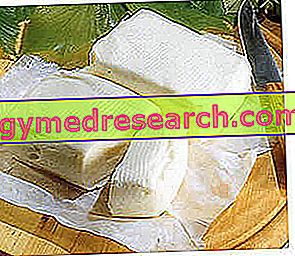What is Crescence?
The growth - more or less correctly called also stracchino - is a soft cheese typical of northern Italy, obtained from pasteurized cow's milk subjected to rennet coagulation, with subsequent seasoning (better defined refining ) of 7-10 days at low temperatures.

Crescence looks like a soft block in the shape of a parallelepiped, with a side of 18cm, flat faces, a 4-5cm heel and an average weight of 1.5-2kg. To be precise, the growth can be divided into two types: a soft one (with a gelatinous aspect) and a firmer one (greater consistency); the appreciability of both varies according to personal tastes.
The name "crescenza" is due to the fact that after a few days the cheese undergoes a softening which makes it similar, due to its consistency, to a Milanese focaccia called " karenza" . The more or less improper synonym "stracchino" derives from a characteristic of the milk of origin; the growth, in fact, is (or should be) derived from the processing of " overcooked " (ie tired) cows because they have survived transhumance. For this reason, in the past the growth represented a typical winter processing, while today it is widely distributed also in the other seasons; the dairies involved in the production of growth are mainly located in the provinces of: Milan, Pavia, Cremona and Brescia. NB . As a synonym, some also improperly use the term "robiola".
Crescenza or stracchino?
Based on the aforementioned, the growth or stracchino should be the fruit of the processing of a poor and watery milk; some say that the type of consistency (soft or soda) of this cheese depends on the season in which it is produced. In my opinion, the milk coming from "overcooked" cows should be available only after the transhumance, therefore, the summer growth would have no way of existing; moreover, if the distinction between the two cheeses depended in some way on the milk of origin, the nutritional characteristics should be quite divergent, but this is not the case. It could therefore be inferred that the "real" crescenza or stracchino (winter and from overcooked cows), to date, is not so easy to find; moreover, it is conceivable (but debatable) that the consistency of one or the other product varies more than anything else on the basis of the composition of the biological starters or the degree of seasoning, rather than the milking period.
That said, the fact remains that the food composition tables differentiate growth from stracchino, creating some confusion about the origin and processing of these two fresh soft cheeses.
Hygiene and Conservation
Crescence is a fairly perishable product, which requires both storage after refrigeration and short-term consumption (within a few days). However, at the production level, growth does NOT have a significantly high microbiological risk, since it is obtained from the processing of pasteurized milk; it is also easily digestible (if compared to more mature cheeses) MA does not boast a considerable presence of live lactic acid bacteria.
Gastronomy
Crescence is an extremely appreciated and widely consumed dairy product, therefore composed and distributed on an industrial scale. Being a soft cheese, without crust and spreadable, the use of growth is mainly to accompany bread or other analogues; from the associative point of view, it is pleasantly close to white or rosé wines with a light body, not very demanding and possibly indigenous to the specific dairy production area (Soave superiore, Valcalepio, Chiaretto del Garda, etc.).
Nutritional Properties
Crescence is a derivative of whole cow's milk, therefore it contains both cholesterol and saturated fatty acids; obviously, since it is not a product aged for a long time but only "refined", the nutritional concentration of fat is less problematic to manage and more contextualizable in the various diets. However, remember that both saturated lipids and cholesterol are nutrients to keep under control in the diet of those suffering from hypercholesterolemia or those who still have a high cardiovascular risk.
The growth also contains a good amount of high biological value proteins and, in the absence of oily condiments, can constitute (albeit in grammages equal to 30%) a valid alternative to meat dishes and fishery products (as befits the lacto regime -vegetarian). The few carbohydrates present are represented by lactose, harmless to the healthy subject but problematic if taken by the intolerant.
From a saline point of view, growth provides a fair amount of sodium, which makes it potentially unsuitable for the diet against hypertension; on the other hand, the remarkable concentrations of calcium contextualize it successfully in the diet of the growing subject and the elderly (taking care to keep the TOTAL phosphorus within the right limits).
As far as vitamins are concerned, growth is rich in vit. A (retinol) and contains a small dose of vit. E (tocopherols); there are no data useful for the estimation of B vitamins, but it is likely to believe that they are present.
Nutritional values
Nutritional composition of Crescenza and Stracchino - Reference values of the INRAN Food Composition Tables
| Chemical composition and energy value of foods per 100g of edible portion | Growth | Stracchino | |
| Edible part | 100.0% | 100.0% | |
| water | 58, 3g | 53, 5g | |
| Protein | 16, 1g | 18.5 g | |
| Lipids TOT | 23, 3g | 25, 1g | |
| B.C. saturated fats | - g | - g | |
| B.C. monounsaturated fats | - g | - g | |
| B.C. polyunsaturated fats | - g | - g | |
| Cholesterol | 53, 0mg | - mg | |
| TOT Carbohydrates | 1, 9g | tr | |
| Starch / Glycogen | 0.0g | 0.0g | |
| Soluble sugars | 1, 9g | tr | |
| Dietary fiber | 0.0g | 0.0g | |
| Power | 281, 0kcal | 300, 0kcal | |
| Sodium | 350, 0mg | - mg | |
| Potassium | 110, 0mg | - mg | |
| Iron | 0.1mg | 0.3mg | |
| Football | 557, 0mg | 567, 0mg | |
| Phosphorus | 285, 0mg | 374, 0mg | |
| Thiamine | - mg | - mg | |
| Riboflavin | - mg | - mg | |
| Niacin | - mg | - mg | |
| Vitamin A | 135, 0μg | - µg | |
| C vitamin | tr | 0, 0mg | |
| Vitamin E | 0, 45mg | - mg | |
Vegan Stracchino - Spread Vegetable Cheese
X Go to the Video Page Go to the Video Recipes Section Watch the video on youtubeBibliography:
- Cheese atlas - G. Ottogalli - Hoepli - pag 219-220.



